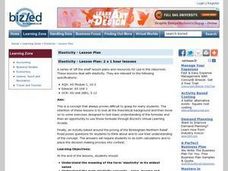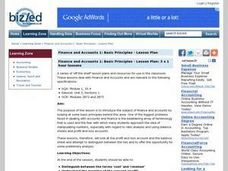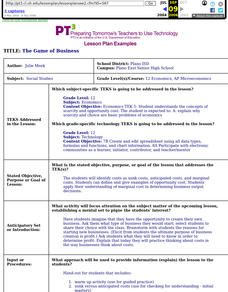Curated OER
Invest In Yourself
Students learn about budgeting, saving, dept, financial management, opportunity cost, and self-regulation. In this financial management lesson, students apply their knowledge of finance components and create their own web based plan...
Curated OER
Spend, Save, Invest or Donate (9-12)
Young scholars explore the concept of personal finance. In this philanthropy lesson, students examine decisions they make about money as they discover the definitions of philanthropy, resources, scarcity, choice, benefits, costs,...
Curated OER
The Soviet Choice For Growth
Students examine five major events in Soviet History to introduce the concept of opportunity cost. They identify considered alternatives at the time of decision and examine benefits and cost. They apply these ideas to a typical school day.
Curated OER
Costs of Providing for animals
Students explore the necessary costs of animals shelters and taking care of one pet. For this providing for animals lesson, students calculate the costs of keeping a pet. Students understand the need for outside funding for animal shelters.
EngageNY
Comparison Shopping—Unit Price and Related Measurement Conversions II
Which rate is greater and by how much? Pupils continue to compare rates to solve problems in the 20th portion of a 29-part series. Rates are presented in a variety of representations either using the same representation or different...
National Endowment for the Humanities
Edgar Allan Poe, Ambrose Bierce, and the Unreliable Narrator
Stories by Edgar Allan Poe and Ambrose Bierce provide readers with an opportunity to investigate unreliable narrators. The lesson plan begins with an activity about different types of point of view and continues as scholars apply their...
National Endowment for the Humanities
Introducing Metaphors Through Poetry
Metaphors are word pictures, creating images in our brains that draw readers to consider how two seemingly unrelated items are alike. Poems by Langston Hughes, Margaret Atwood, and Naomi Shihad Nye provide learners with an opportunity to...
Literacy Design Collaborative
Catching a Grenade: How Word Choice Impacts Meaning and Tone
Beyonce's "Halo" and Bruno Mars' "Grenade" provide eighth graders with an opportunity to consider how a writer's choice of words can create a very different tone even when the subject is the same. After a close reading of both lyrics,...
National Woman's History Museum
Country to City
After reading a series of primary source documents, groups compare the lives of and opportunities available to rural and urban women in the 19th century to rural and urban life in the 21st century. As an exit ticket, individuals craft a...
Curated OER
Economics: Elasticity of Prices
Students discover the elasticity concepts of price, income, cross elasticity, and elasticity of supply. They apply this knowledge to an activity about Britain's Birmingham Northern Relief Road.
Curated OER
Finance and Accounts 1: Basic Principles
Students distinguish between the terms 'cost' and 'revenue' and examine the concept of 'profit'. They analyze the difference between a profit and loss account and a balance sheet.
Federal Reserve Bank
Lesson 1: Katrina Strikes
Most families have an emergency kit in their home with flashlights, water, and extra food. But what happens to your money when disaster strikes? An economics lesson focused on the aftermath of Hurricane Katrina in 2005 demonstrates the...
Curated OER
Minty, A Story of Young Harriet Tubman
Fourth graders describe the life of Harriet Tubman. They define opportunity cost. Students identify the opportunity cost of each of several choices made by Harriet Tubman. They are explained that Harriet Tubman was the first African...
Curated OER
Banking on the Future: Penny Drive
Young scholars study why philanthropy is needed and learn to complete a penny drive. In this philanthropy instructional activity, students learn the need to invest money for future purposes and identify a cause in the community to hold a...
Curated OER
Get in the Newspaper Habit
Dive into journalism with your high schoolers! The resources provided here will help your learners write unbiased, clear, and succinct newspaper articles. First they spend time sifting through stacks of articles, filling out a graphic...
Carolina K-12
Factors of Production and Economic Decision-Making
Class members begin this engaging economics activity by listing all the resources used in producing a car and using that example to draw parallels to the four primary factors of production: capital goods, labor, natural resources, and...
Texas Center for Learning Disabilities
Chapter 4 Teacher Guide and Student Log
"Piano Lessons," the fourth chapter in Tony Johnston's Any Small Goodness: A Novel of the Barrio provides an opportunity for class members to work in their study teams to develop and answer Level 1, Right There questions about the novel.
Curated OER
What Is Technology, and How Does It Benefit Us?
Students examine and define what technology is as well as the differences between science and technology. They assess the role of science and technology in society, conveniences technology offers and create a chart to compare the...
School Improvement in Maryland
Socio-Economic Goals of the Government
Equity. Increased productivity. Price stability. Environmental protection. Decreased poverty. Governments establish socio-economic goals and then must design and fund programs to address these goals. Groups investigate various programs...
Curated OER
"Tarantula Shoes," by Tom Birdseye
Learners read a book and explore spending, saving, opportunity cost, and trade-offs. They keep a diary of expenses to track their spending and examine their opportunity costs.
Curated OER
The Game of Business
Students practice the economic concepts of scarcity and opportunity cost. They imagine creating their own businesses and brainstorm what they need to know in order to determine when the business is profitable.
Visa
Cars and Loans
What's the best way to pay for a car? Should I buy used or new? Can I realistically afford a car? Pupils discover the ins and outs of buying a car, from how to shop for car insurance to the advantages and disadvantages of leasing.
Curated OER
Lesson on economic value of education
Students use economic reasoning to analyze both the short-term and long-term benefits and opportunity costs of educational choices, identify incentives that may influence students' career decisions and solve an "economic mystery"
Curated OER
Introduction to Economics
Students discover the basic economic problem: scarcity; examine how "there is no such thing as a free lunch" (opportunity costs); and define economics. They act out a play demonstrating basic economic principles.
Other popular searches
- Scarcity Opportunity Cost
- Opportunity Cost Game
- Budgeting Opportunity Cost
- Opportunity Cost Activity
- Marginal Opportunity Cost
- Choices and Opportunity Cost
- Internet Opportunity Cost
- Trade, Opportunity Cost
- Trade Offs Opportunity Costs
- Trade Offs Opportunity Costs
- Online Opportunity Costs
- On Line Opportunity Costs

























